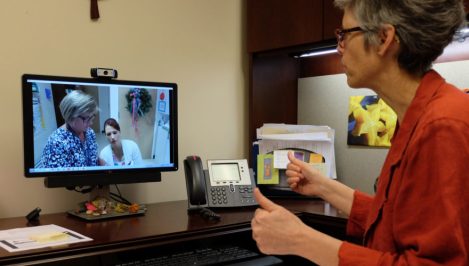ST. ROBERT, Mo. (AP) — With a population just shy of 5,000, the town of St. Robert lies just south of the heart of Missouri. It’s one of the many rural towns in the state that finds alternatives to health care access through the internet.
Since the early 1990s, the telehealth network has helped connect patients to health care providers from their own homes. Increasing technology has made the service more efficient, with live audio and video sessions enhancing virtual health care.
The Columbia Missourian reports that telehealth services rely on internet access to conduct sessions, and Missouri is one of the worst states in terms of broadband access in rural areas.
 https://compliance4all14.files.wordpress.com/2018/01/telehealth.jpg?w=150&h=100 150w, https://compliance4all14.files.wordpress.com/2018/01/telehealth.jpg... 300w, https://compliance4all14.files.wordpress.com/2018/01/telehealth.jpg 750w" sizes="(max-width: 492px) 100vw, 492px" width="492" height="328" />
https://compliance4all14.files.wordpress.com/2018/01/telehealth.jpg?w=150&h=100 150w, https://compliance4all14.files.wordpress.com/2018/01/telehealth.jpg... 300w, https://compliance4all14.files.wordpress.com/2018/01/telehealth.jpg 750w" sizes="(max-width: 492px) 100vw, 492px" width="492" height="328" />
Jon Moore, a physician’s assistant at Mercy Clinic Family Medicine in St. Robert, relocated to the town from Fort Leonard Wood in 1998 and has been practicing dermatology with telehealth services since then. Despite believing that dermatology is underserved in the area, Moore says that telehealth services are invaluable in a small community like St. Robert. Moore said that as broadband access has improved, the health services have improved.
“We had some big problems when we were first choosing the equipment back in the early 2000s,” Moore said. “A couple of times, telemedicine degenerated into telephone medicine … I ended up describing the lesions over the telephone because we just couldn’t get it going. With the evolution of broadband, it’s gotten better and better.”
As far as who Moore sees, patients utilizing telehealth services do so for a variety of reasons. While many may use it for convenience, others may choose virtual services to reduce the cost of health care.
“If (people) are unemployed, they may not have a car, or if they have a car, they may not be able to afford gas,” Moore said.
“I’ve had patients that were very well insured and were just happy with the convenience of not having to get in a car and drive (to the closest specialist,) and I’ve had others that were just dirt poor or nursing home patients that just couldn’t travel.”
Sometimes uninsured or underinsured patients can’t afford to consult with a specialist, he said, “so the challenge is there.”
 https://compliance4all14.files.wordpress.com/2018/01/duplin_thumbsup-880x500.jpg?w=150&h=85 150w, https://compliance4all14.files.wordpress.com/2018/01/duplin_thumbsu... 300w, https://compliance4all14.files.wordpress.com/2018/01/duplin_thumbsu... 768w, https://compliance4all14.files.wordpress.com/2018/01/duplin_thumbsu... 880w" sizes="(max-width: 469px) 100vw, 469px" width="469" height="266" />
https://compliance4all14.files.wordpress.com/2018/01/duplin_thumbsup-880x500.jpg?w=150&h=85 150w, https://compliance4all14.files.wordpress.com/2018/01/duplin_thumbsu... 300w, https://compliance4all14.files.wordpress.com/2018/01/duplin_thumbsu... 768w, https://compliance4all14.files.wordpress.com/2018/01/duplin_thumbsu... 880w" sizes="(max-width: 469px) 100vw, 469px" width="469" height="266" />
Karen Edison is the medical director of the Missouri Telehealth Network. Edison has specialized as a dermatologist for over 20 years and frequently fronts teledermatology sessions with her patients.
“I’m taking care of (patients) through video conference so I see their skin,” Edison said. “They send pictures to me ahead of time and I look at all their skin photos and then I go in the room and talk to them over the computer. It’s just like it is in person, it’s just using technology to bridge distance.”
Edison says that equipment and technology have become cheaper over the years to operate telehealth services. Today, clinics may only need to use a laptop or desktop computer to communicate with their patients and conduct sessions.
“When we first started doing telemedicine, the local rural clinics had to have some very expensive video conferencing equipment,” Edison said. “Today, we use our regular computers. You don’t need to have anything special besides … broadband access to make that secure and high quality.”
“We still have rural areas in Missouri that don’t have high-quality broadband access and this is a problem all over the country in rural areas, but especially in the frontier areas of our country.”
Here for Full article http://snip.ly/gnrik
 https://compliance4all14.files.wordpress.com/2018/01/telehealth.jpg?w=150&h=100 150w,
https://compliance4all14.files.wordpress.com/2018/01/telehealth.jpg?w=150&h=100 150w,  https://compliance4all14.files.wordpress.com/2018/01/duplin_thumbsup-880x500.jpg?w=150&h=85 150w,
https://compliance4all14.files.wordpress.com/2018/01/duplin_thumbsup-880x500.jpg?w=150&h=85 150w,
You need to be a member of MedTech I.Q. to add comments!
Join MedTech I.Q.